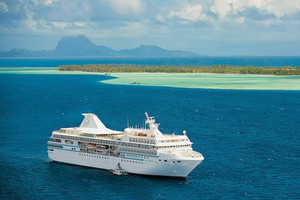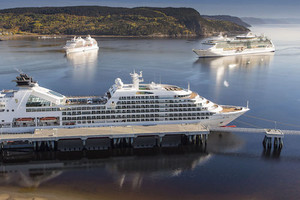
Inspiring generations of artists and writers, it’s easy to see why French Polynesia’s islands enchant visitors. Picture perfect blue lagoons, colourful reefs, volcanic mountains, bright flowers and a real atmosphere of tranquility combine; in exotic Tahiti they all come together to create one big natural water-colour that typifies the tropical idyll. French Polynesia is more popularly known as Tahiti and Her Islands, and it’s divided into five separate archipelagos - the Society Islands which includes the main island of Tahiti and the administrative capital of Papeete, the Marquesas, the Tuamotus, and the remote and tiny Australs and Gambier Archipelago. Each group is a little bit different, although they were all formed by volcanic activity, creating a landscape of mountainous islands and coral atolls, or reefs which are just above the water surface surrounded by a natural lagoon. In part one of this feature we explored the Society Islands, but what else you should know about this fascinating region?
Paradise Rediscovered On Motu Mahana
One of the highlights of nearly every Paul Gauguin cruise in Tahiti is a day spent on Motu Mahana. It’s a private island for cruise guests only, and this idyllic motu is flanked by Taha’a’s mountains on one side and Bora Bora’s cloud-piercing peaks on the other. Shimmering lagoon water laps gently against the edges of a pristine white beach dotted with teak deck chairs, umbrellas and hammocks strung between palm trees. The flowers are incredible and colourful sprays of bougainvillea spill over the trees and pathways, and tropical hibiscus with their pink and scarlet petals face up at the sun. The unavoidable lure of the warm, crystal clear waters can turn even the most sedentary beach lover into a snorkeler or kayaker, and thanks to a floating bar, it’s also possible to wallow in the balmy water sipping a Pina Colada made in a fresh coconut husk, while colourful fish dart in and about your feet. The day on Motu Mahana is also the perfect opportunity to sample traditional Tahitian cuisine in a tropical paradise setting. From starters like poisson cru, which is tuna marinated in coconut milk and lime, to grilled local fish including mahi mahi, roast suckling pig, and side servings of yam and taro, it’s a feast that defines the cuisine of the islands. Although main ingredients are fairly basic, French and Chinese influences means they can all be prepared in different styles, from fish or meat cooked in either coconut milk, garlic or curry to simple grills with tropical fruit on the side, and it shows that Tahitian cuisine has taken on an international flavour which is heavily influenced by the fresh produce unique to the region.
The Marquesas
As the Paul Gauguin cruises into Omoa Bay, the eerie sounds of conch shells and drums pounding out a driving rhythm increase in intensity. Volcanic cliffs almost one kilometre high drop straight into the ocean, and in between are deep gorges with lush jungle, and it’s a surreal arrival into one of the most remote and unspoiled of the Tahitian Isles, Fatu Hiva. There are no airports, no jetties, no marinas and a concrete slab at the end of the point on Omoa Bay is the only way on and off the island via an inflatable zodiac. On many days, big swells make it impossible to set foot on Fatu Hiva, and this fact in itself sums up the essence of the Marquesas. They don’t get many visitors, but when they do, a buzz goes around the 500 or so inhabitants who turn out in traditional dress to greet the new arrivals, beating drums and singing traditional songs. In the main square, local artisans set up and display their handmade creations and it’s easy to see why Marquesan handicrafts are regarded as among the most authentic and beautiful cultural creations in Polynesia. A traditional dance is performed but this is not a “show” as performed by professional troupes in five star resorts in the Society Islands. It’s a show of village pride and an authentic snapshot into Marquesan culture.
Located nearly one and a half thousand kilometres north-east of the main island of Tahiti, the Marquesas’ isolation means they are relatively untouched by tourism. A smile from a local is genuine, and when they want to take you around their village they don’t expect to get paid as they’re just showing off their lifestyle and heritage. Of the 12 islands that make up the group, just six are inhabited, and only four have tiny air strips, with flights infrequent and expensive. Around Omoa village, and in nearby Hanaveve village, fruits grow wild by the roadside and in between the houses are coconuts, breadfruit, local mountain apples, oranges, mangoes, papayas, bananas, avocados and Tahitian grapefruit, aka pamplemousse, which is twice as large as a normal grapefruit and so much sweeter than most varieties. The breadfruit grows on trees up to 20 metres tall and is an important starch of Marquesas which can be roasted, boiled or baked. The fishing boats bobbing next to the quay are evidence that seafood is also one of the staple foods for the locals, as are the children using bamboo poles and hand lines to catch fish, while further inland families cast nets to catch freshwater shrimp from rivers at the back of the valley.
The Marquesas possess a powerful and overwhelming physical presence and sheer volcanic cliffs rise dramatically out of the Pacific Ocean. The jagged peaks rise side by side more than a kilometre up, creating plateaus at high altitude and steep valleys with lush vegetation which are home to wild horses and goats brought by European settlers. Most of the Marquesan Islands feature partly sunken caldera, which create a natural amphitheatre among the towering mountains and this is where the villagers choose to settle. The locals call their region Te Henua Enana which means “the Land of Men” in reverence to their stunning backdrop. The history of Tahiti and Her Islands can also be traced back to the Marquesas - the first Polynesians arrived in 300AD as part of a migration from South East Asia, which was around five hundred years before settlement in the Society Islands. Only a very jaded traveller wouldn’t fall for French Polynesia’s beauty and charm; the dramatic landscapes, the exotic flowers, the crystal clear waters, and the sunsets which light up the sky and ocean in a 360 degree panorama of magnificent colours.
Gauguin’s Legacy
Many people have fallen for the extraordinary charms of Tahiti and her Islands, and among the most famous is the legendary French artist, Paul Gauguin. He arrived in Tahiti in 1891 financially ruined, in search of a new life, and determined to discover as much as he could about the Polynesian peoples and their culture. But the exotic idyll he’d imagined wasn’t what he saw when he stepped off the steamer docked in Papeete. The Pacific island was a colony, with French officials and soldiers strutting around much the same as they did back home - two of the things from which he was trying to escape. In the years which followed, however, Gauguin painted what he saw or imagined the real Tahiti to be: well-rounded women wearing colourful pareu - Tahitian sarongs - long haired warriors riding bareback along the beaches, and locals washing horses in the foaming surf.
Although Gauguin lived on Tahiti for much of the 1890s, he spent his last years on the Marquesas Island of Hiva Oa, one of the northernmost islands of French Polynesia, and died of syphillis in 1903. He is buried in Calvaire Cemetery, which is perched on top of a hill above Hiva Oa’s main town of Atuona, overlooking the romantically named Bay of Traitors. Gauguin’s grave is made of red sandstone and shaded by a frangipani tree, with one of Tahiti’s legendary landscapes as a backdrop with jagged mountains draped in lush, green tropical foliage. His descendants are said to be scattered all over French Polynesia and some are said to have distinctly European features, while others are rumoured to bear his trademark red hair. But for any visitor to the Marquesas, a walk around the island is evidence enough that the Tahiti Gauguin depicted in such vivid colour and form lives on.
- By:
- Joanna Hall
Reviews
-
Idyllic
We stopped in Tahiti for a few days en route from Canada to Australia and LOVED it apart from it being pricey. People lovely, beaches unmatched, and the weather was amazing. The food good too although wine was crazy expensive. Would love to go again and maybe cruising is the way to go?
-
Bucket List Dream
Ah it's on the bucket list but this part of the world is very expensive compared with parts of Asia so I mark it down a star....would love to go one day though.











